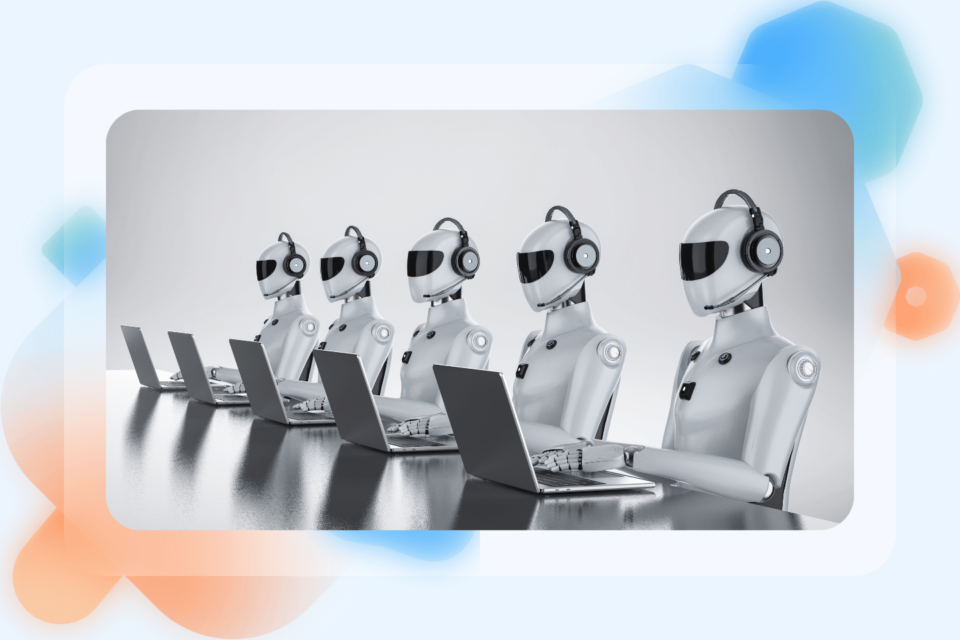With the evolution of technology, people get used to having what they want when they want it. Additionally, online transactions have raised the bar for customer service standards.
But what if customers come flooding in just when your support team has clocked out? Will you leave them hanging until the morning?
Or what if your customer service team is swamped during peak season? Do you leave your customers indefinitely on hold?
Fact check—every missed customer query is a missed sales opportunity. This is because customer service is the top factor that influences customer loyalty. What does this mean for businesses? It’s time to aim for a world where no customer is left unattended (even in the middle of the night!).
Now, here’s some good news—this is very much possible already thanks to automation in customer service.
Want to know how it can advance your customer support? Dive into this article to see the pros and cons of various customer service automation examples, support automation, how solutions like chatbots work, and the best practices when integrating them into your business.
What is customer service automation?

Automation in customer service is the use of technology to resolve and automate customer support requests with little to no contact with human customer service agents ever. Ideally, it can improve support teams’ productivity, reduce wait times of inquiring customers, and minimize human error in your workflows.
Some examples of automated customer service include:
- Chatbots
- Automated ticketing systems
- Automated technical support
- Automated confirmation email
- Interactive voice responses (IVR)
So, if you’ve got a ton of customers hitting you up with questions, orders, or even complaints (yes, it happens) simultaneously, relax. It doesn’t have to be difficult.
With customer support automation, you no longer need to handle all of that one by one. According to statistics, 63% of businesses in retail already use AI in customer service to improve how they interact with customers.
Dissecting the power of automation in customer service

When we talk about automation—whether in customer service or not—we’re looking at a tech-powered approach to repetitive tasks. So, of course, there’ll be its own perks and drawbacks.
In this section, let’s dissect the ups and downs, pros and cons of customer service automation solutions:
Pros: The transformative power of an automated customer service system
You get a lower response time.
Perhaps the core of customer service processes is speed. Customers don’t just enjoy quick responses—thanks to the possibilities brought by technology, they now demand them. For common queries like “how to order” or “how to use,” automated systems can handle them and respond to them in a matter of seconds.
IBM found that automated customer service systems are up to 80% quicker than human agents at answering questions. Why? Because customers don’t operate on a 9-to-5 schedule! When you have round-the-clock service like automated systems, these tools don’t need breaks or don’t get overwhelmed. No matter how large the ticket volume gets, they can handle repetitive queries like these with ease.
You easily cater growing customer base when scaling.
Speed is only part of the equation. Another pro of automated service is how it is instrumental in helping businesses scale. As your business takes off and continues to grow, the volume of customer inquiries also surges. For eCommerce businesses, this is also evident during major sale events and peak shopping season—take Black Friday and Cyber Monday for example.
However, traditional means of scaling up customer service, like hiring more staff, can be very costly. Automation has the upper hand here because AI-powered chatbots can effortlessly handle routine questions, so you support an ever-growing customer and knowledge base. Also, automated systems can help develop plenty of help articles, FAQs, and knowledge bases so you can also provide robust self-service options for customers who prefer finding answers on their own.
You enhance user experience.
Let’s shift focus to your customers’ experience. Consistency across various customer service channels (email, phone, social media, live chat, and more) is a must for a seamless user experience. Automation integrates these mediums, ensuring that customers receive the same level of service, exact info, and brand voice.
Businesses that recognize the importance of omnichannel customer engagement consistency enjoy a 10% year-over-year growth, a 10% jump in average orders, and a 25% improvement in closing rates.
You provide personalization at scale.
The power of automation to personalize at scale continue to redefine how businesses interact with their customers. Automated customer service systems can access and analyze a lot of customer data, such as past purchases, browsing behaviors, and preferences. This way, you can ensure that customers each get a unique experience. The Zendesk Customer Experience Trends Report found that 70% of consumers prefer to engage more with companies that offer smooth, personalized, and seamless customer service.
You become more proactive.
Automation in customer service improves businesses’ ability to run proactive initiatives or anticipate customer engagement—and that increases customer retention by 3% to 5%. These help businesses reach out to their customers even before they encounter issues or even realize they need assistance.
For example, if data shows that customers often contact support after using a product for a certain amount of time, the system can trigger a proactive outreach and provide helpful tips to satisfied customers. For some eCommerce businesses, a chatbot may be triggered when a customer is found to be spending too much time in the checkout page without finalizing the transaction. The chatbot can ask if the customer needs help with anything.
Cons: Challenges and obstacles of automating customer service (if not carefully implemented)
There’s a potential loss of the human touch.
A major concern about automation in general, most especially with customer service, is the customer engagement being “too robot-y.” While automated systems are excellent at handling repetitive tasks and inquiries, they’re still incapable of understanding the nuances of human emotions and complex situations. As a result, customers may end up becoming frustrated especially in sensitive or complicated situations.
In a survey done by PwC, almost 75% of their respondents say they want more human interaction in the future, not less. One recommendation for this is to program your customer service software and chatbots to hand off high-level concerns to a human customer support team. After all, a human agent’s customer service skills are very different from a chatbot’s features.
It can be costly.
One challenge of automated customer service software is its initial setup cost. Implementing an effective automated system requires an investment, and this can be a steep barrier, particularly for smaller businesses with limited resources.
Additionally, some software can be complex. This means you will need skilled personnel to manage and maintain it from the get-go or invest in training for staff who will be using it.
There might be a learning curve involved.
Integrating the automation technology into customer service operations isn’t an easy thing. Some software for automation requires a learning curve. For your staff, especially those not familiar with advanced technological tools, adapting to automated systems can be challenging.
They need to learn how to operate, manage, and troubleshoot these systems. This may temporarily reduce productivity as customer reps need to shift their focus to learning the new technology.
Enter chatbots—your 24/7 support heroes

After reviewing the overall picture of automation in customer service, let’s zoom in on one of the biggest trends of this technological self service revolution: Chatbots.
Here’s an inside look into how they work, their benefits, and the crucial role they play in advancing customer service.
How do chatbots work?
Chatbots are products of our technology becoming smarter. They were introduced as a response to the growing need for faster and more efficient customer support.
Here’s a simple illustration of how they work:
- First, chatbots use machine learning algorithms to process user inputs. The bot uses its program to figure out what the user is asking and tries to understand the meaning of it.
- Using Natural language processing (NLP), it decodes and interprets human language. This technology enables chatbots to pick up on customer queries and return human-like answers in their responses.
- Lastly, chatbots learn and evolve from every interaction. Picture it like this: if a chatbot doesn’t have the right answer once, it will continuously learn and do better next time. Over time, chatbots become more adept at handling a wider range of queries, improving their effectiveness and the customer experience.
What are the benefits of using chatbots?

Surely, there’s a good reason that chatbots are such a popular tool in customer service. Take a look at these three advantages in detail:
- They don’t need breaks or sleep. One of the most significant advantages of chatbots is their 24/7 availability. This continuous availability ensures that customers can get assistance whenever they need it—even on holidays and off-hours. These chatbots are particularly beneficial for businesses that have a global customer base or operate in multiple time zones.
- They handle multiple queries at once. Chatbots can handle multiple requests simultaneously, which is something that would be challenging and costly with human agents. This capacity to manage high volumes of interactions all at the same time means customers experience short wait times. This feature is especially useful when there are spikes in customer service requests, like during promotions or holidays.
- They don’t have moods. Yes, chatbots aren’t moody—because they’re not human. They provide a consistent quality of service day in and day out. Human agents? No matter how experienced, they can have variations in their responses due to factors like mood, exhaustion, or subjective interpretations.
So, what’s their role in customer service?
In most customer service setups, chatbots start things off. They’re able to resolve common, straightforward queries and collect them before handing them over to support reps. This not only speeds up the resolution process but also ensures that human customer support agents are working more efficiently.
As chatbots interact with customers longer, they collect preliminary information. This includes the types of questions asked, customer preferences, and feedback. Insights gained from analyzing this customer data can provide a deeper understanding of common customer issues, preferences, and overall customer satisfaction. These insights are invaluable for businesses when it comes to refining their products, services, and overall customer service strategy.
Put simply, chatbots enhance the customer service. The chatbot statistics below prove their usefulness in customer service:
- 74% of web users prefer chatbots for simple queries.
- 80% of customers who have used chatbots are satisfied with their experience.
- Over $1.3 trillion is spent each year by businesses on customer service, and it’s estimated that chatbots can reduce that by 30%.
Best practices for integrating automation in customer service

If you’re now planning to incorporate chatbots or customer service automation tools in general into your workflow, we list five best practices for your seamless integration.
Ensure a proper transition of the team
Are you excited to harness the full potential of automation in customer service? Then, ensure your own support team is engaged and motivated. Start by addressing any concerns or fears, such as job security. Emphasize how automation will complement rather than replace their roles.
During this transition, you must prepare your team (not only technically but also psychologically) for the changes automation and artificial intelligence will bring.
Support adequate onboarding
Adequate onboarding is more than just getting everyone started with new software. The actual course of action is to have comprehensive training sessions. These should cover both the technical aspects and their practical applications in day-to-day scenarios.
Customize to your actual business needs
Don’t just copy how your competitors use chatbots. Tailor your automated tools to reflect your specific service style. Customization ensures that interactions via your automated support systems feel more personal and less robotic. This might involve tweaking the language used by chatbots or customizing automated email responses to align with your brand’s voice.
Strategize team restructuring
Team restructuring is leveraging your team’s dynamics of automation while enhancing human skills. The key is simple—identify which tasks are best suited for automation and which require more human involvement and participation. For example, complex customer service tasks with problems or providing personalized advice.
Most important tip: Blend human touch with automation
This is non-negotiable. Yes, an automated customer service system does the heavy lifting of routine queries. But at the end of the day, they’re still emotionless programs. Still, human empathy and understanding are irreplaceable.
The perfect solution is to create a seamless blend where automation enhances human service, not replaces it. So the best practice is to train your team to add value where automation can’t, like empathizing with deeper customer emotions, providing personalized service, and building more customer relationships. The combination of human touch and technological efficiency increases efficiency while elevating the customer experience.
Complement automation in customer service with the irreplaceable human touch

Definitely, automation in customer service is a move towards more efficient, consistent, and scalable customer service interactions. No questions.
But while it brings impressive advantages in handling volume and providing round-the-clock service—the human element is still irreplaceable. The future of customer service is when the two create a more comprehensive customer service experience. Like GQ Fu, CEO of LTVplus, says, “AI is not here to replace—but to enhance what agents can do.”
Yet, double the value of the indispensable human support agents when especially equipped with training to maximize automation. They now become invaluable assets that bring empathy, understanding, and nuanced problem-solving that technology alone can’t replicate.
Looking to empower your entire customer journey and service with this perfect blend of human expertise and technological efficiency?
LTVplus is your go-to customer journey partner. Book a free call with us for first-class customer service outsourcing solutions bringing this powerful synergy into action.




